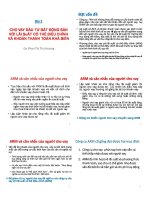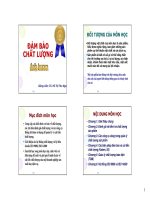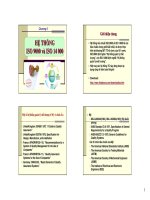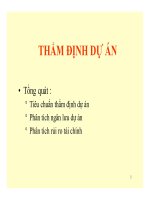Bài giảng môn Phương pháp kiểm tra và đánh giá học tập: Chapter 9 - Phan Thị Thu Nga
Bạn đang xem bản rút gọn của tài liệu. Xem và tải ngay bản đầy đủ của tài liệu tại đây (78.27 KB, 15 trang )
Chapter 9:
Testing the writing skills
Chapter 9:
Testing the writing skills
1.
2.
3.
4.
5.
The writing skills
Testing composition writing
Setting the composition
Grading the composition
Treatment of written errors
1. The writing skills
language use: the ability to write correct &
appropriate sentences
mechanical skills: the ability to use
correct conventions of written language e.g.
spelling, punctuation..
treatment of content: the ability to think
creatively and develop thought without any
relevant information
1. The writing skills (con.)
stylistic skills: the ability to manipulate
sentences and paragraphs and to use
language effectively
judgment skills: the ability to write in an
appropriate manner for a particular purpose,
e.g. the ability to select, organize and order
relevant information, the use of judgment
important in teaching and testing of writing
2. Testing composition writing
The types of writing tasks in the test should
be the ones which students are confronted
everyday.
The candidate’s performance will have met
the following minimum criteria:
Basic level
no confusing errors of grammar or
vocabulary;
a piece of writing legible and readily
intelligible;
able to produce simple unsophisticated
sentences
Intermediate level
accurate grammar, vocabulary and spelling,
though possibly with some mistakes which
do not destroy communication;
handwriting generally legible, expression
clear and appropriate, using a fair range of
language;
able to link themes and points coherently
Advanced level
extremely high standards of grammar,
vocabulary and spelling;
easily legible handwriting;
no obvious limitations on range of language
candidate is able to use accurately and
appropriately;
ability to produce organized, coherent
writing, displaying considerable sophistication
Important notes
Composition writing : a useful testing tool
b/c providing students with an opportunity
to demonstrate their ability to organize
language material, using their own words
and ideas and to communicate providing a
degree of motivation which many objective
tests fail to provide
Important notes (con.)
Ss should be presented with a clearly
defined problem which motivates them to
write; in other words, meaningful situations
should be given.
Composition titles without guidance should
be avoided.
3. Setting the composition
A good topic for a composition determines
the register and style to be used in the
writing task by presenting Ss with a specific
situation and context in which to write.
The difficulty in constructing compositions is
the writing of the rubrics, so sufficient
information must be conveyed by the rubric
in order to provide realistic, helpful basis for
the composition.
4. Grading the composition
A student’s ability to organize ideas and
express them in his / her own words a
skill essential for real-life communication;
composition can be used to provide not only
high motivation for writing but also an
excellent backwash effect on teaching.
A well-defined task in terms of one or two
situational compositions enormously
increasing the reliability of the test
Scoring methods
Compositions may be scored according to one
of the two methods:
(1) the impression method
(2) or the analytic method
(3) the mechanical accuracy or error- count
method (not recommended)
Scoring methods (con.)
The impression method of marking entails
one or more markers awarding a single mark
based on the total expression of the
composition as a whole.
The analytic method depends on a marking
scheme which has been carefully drawn up
by the examiner or body of examiners.
5. Treatments of written errors
Global errors: those involving the overall
structure of a sentence & resulting in
misunderstanding or failing to understand
the message conveyed
Local errors: causing only minor trouble or
confusion in a particular clause or sentence
without hindering readers 'comprehension









